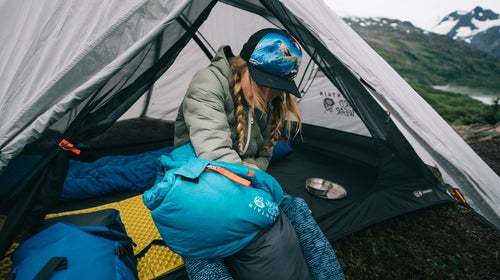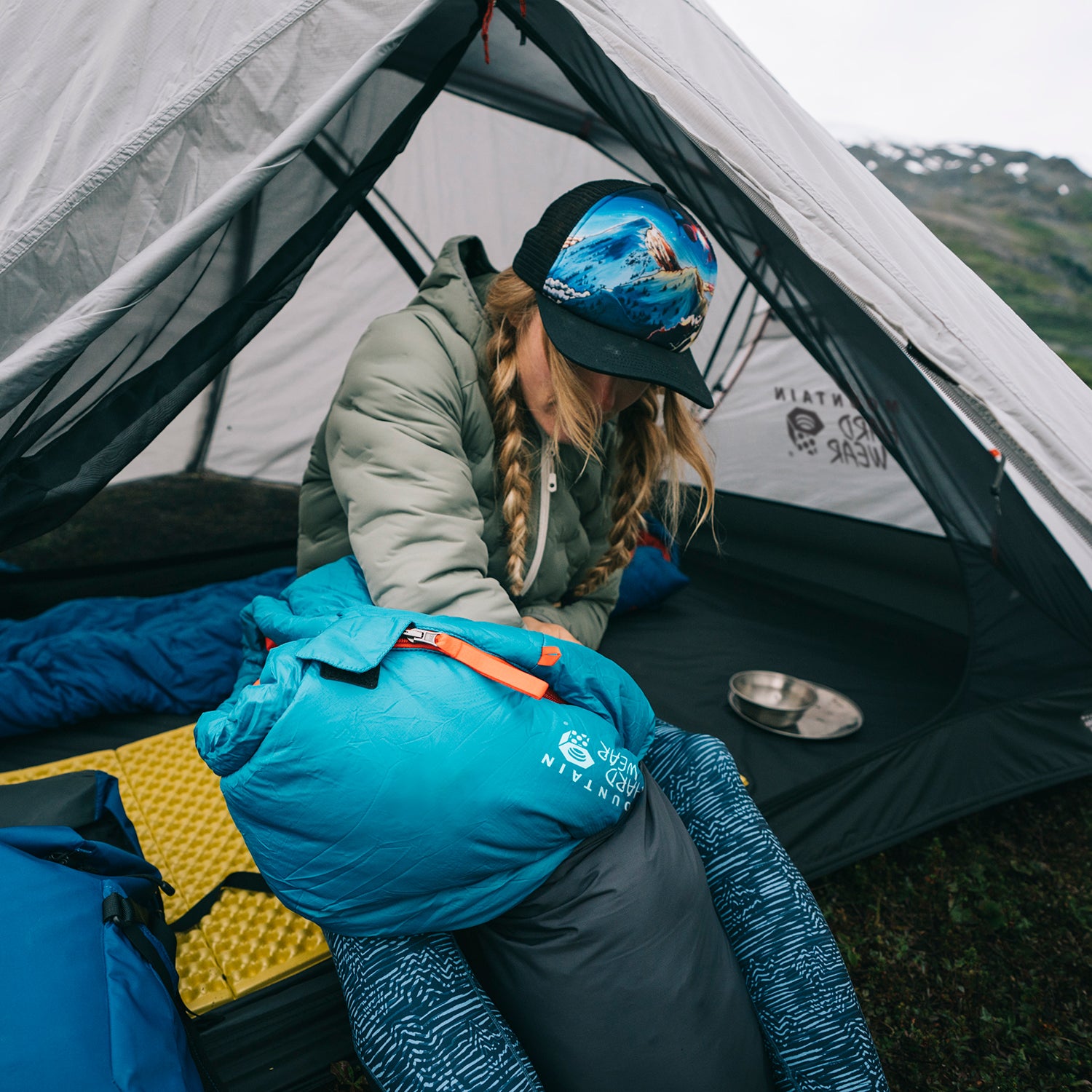One of my all-time favorite pieces of gear is my Mountain Hardwear Women’s Phantom 15 down sleeping bag. It’s nearly ten years old, yet it still performs as well as today’s newest down bags. It lofts up like a soufflé, feels instantly cozy, and keeps me warm on subfreezing nights. In anything other than a dead-of-winter chill, it’s never left me shivering.
It weighs just one pound 15 ounces. And it fits my five-foot frame: there’s no surplus space at the bottom to suck away my body heat, and the mummy cut is cozy but doesn’t feel like a straitjacket. Like many women’s bags, the Phantom is narrower at the shoulders and wider through the hips than the typical men’s model.
I’m a fan of women’s bags in general. Over the past 15 years, I’ve tested comfortable, smartly proportioned versions from Marmot, The North Face, REI, Sea to Summit, NEMO, and Kelty.
Some women, though, give this category an emphatic thumbs-down. Darcy Conover, a ski mountaineer based in Aspen, Colorado, who co-founded Corbeaux apparel, says her first and only experience with a women’s sleeping bag was a disaster. “I was really excited about it, because it had more down in the foot area, where I am always cold, and was supposed to be roomier in the hips,” she recalls. She used it on a trip to Vallecitos, in Argentina, where she climbed and skied Cerro Plata—and shivered for six sleepless nights. “The shoulders felt too tight, and it was just too short,” says Conover, who is five foot nine. She’s stuck with men’s models ever since.
Mountain Hardwear has scaled back its high-end women’s options in favor of more unisex ones. While the brand still offers a couple of women-specific bags, like the Laminina and Heratio, it discontinued the women’s Phantom in spring 2016 (when it was called the Phantasia). The Phantom is currently offered only in a unisex version. That’s because most female customers are looking for a product to withstand cooler temperatures, not a gender-specific cut, says Robert Hollister, Mountain Hardwear’s equipment product line manager.
“Women don’t technically need a women-specific sleeping bag, but rather a warmer option,” says Hollister. “We discontinued the women’s Phantom because the high-end down-bag consumer is generally very savvy, and if that female Phantom customer runs cold, she can always select a [different bag rated to a lower temperature].”
Many women do run colder than men, and the evidence goes beyond anecdotal. European Norm (EN) ratings, the testing scale most sleeping-bag companies in Europe and the U.S. rely on, have confirmed that most women need more insulation to stay comfortable. (The EN ratings ensure that sleeping bags from different retailers and manufacturers are comparable in terms of temperature.)
For instance, on chilly nights Mountain Hardwear’s unisex Phantom 15 might keep me comfortable only if it’s 20 or even 25 degrees out. If I want to stay warm at 15, I may need to buy the Phantom Torch, which is comfort-rated to 3 degrees. But that’s a major step up in both insulation and weight: the Torch weighs in at 2 pounds 11 ounces. Since I’m shorter than the average guy, the Torch would also give me a lot of warmth-sucking dead space at my feet. I’m glad I snapped up the women’s Phantom while I could; otherwise, I’d have to wait until spring 2019, when Mountain Hardwear will start offering shorter versions of its unisex bags. The new unisex short will be equivalent to my women’s regular.
Ultimately, the type of bag women need probably comes down to size. If I were five-11, like my Outside editor, Abby, I’d probably follow Mountain Hardwear’s advice and get the men’s Phantom Torch. It might turn out to be warmer than I need for most spring, summer, and fall outings, even here in the chilly Rocky Mountains. But I could always open the zipper for venting, and the extra ounces wouldn’t impose a major weight penalty on shorter trips.
Still, I remain convinced that most women of small to average height and size would be better served by a women’s sleeping bag. I’m short and hippy, and I sleep cold. No wonder I’ve liked bags that address these three traits. I’m not alone. My friend, cyclist Saris Mercanti, swears by women’s sleeping bags. “I’m way colder in a men’s or unisex bag,” she attests.
That’s why REI Co-op is among the companies that remain dedicated to women’s sleeping bags. “Through temperature testing, we know women generally sleep cooler than their male counterparts,” says Paul Calandrella, Co-op Brand’s director of product strategy. “We design women’s bags with more insulation to arrive at the same comfort level. Additionally, REI Co-op Brand sleeping bags are designed with body mapping to give people a more complementary fit where they need it most.”
I’ve used the REI Co-op Joule 21 ($299 for regular length) on late-autumn, high-altitude trips in Switzerland’s Alps and Colorado’s Sawatch Range and stayed delightfully cozy. It’s even available in a long length ($319) to give tall women the body-mapped insulation boost that Calandrella describes.
The Kelty Women’s Sine 20 ($280) is another bag that impressed me on weekend backpacking trips around Colorado and in Wyoming’s Tetons. The fabric feels nice and silky, the 800-fill down is DWR-treated to repel moisture and maintain full loft in soggy conditions, and a separate zipper at the foot makes it easy to escape mummified confinement by kicking your feet out the bottom of the bag. I found the curved upper zipper that stretches across my torso to be tricky to operate during exits in the middle of the night, when I’m too groggy to remember that it doesn’t extend down the side. (Old habits die hard.) But the bag hits a nice balance for backpacking and car camping; it packs down small, yet the shell fabric isn’t so light and fragile that I worry about tearing it on a camp chair.


